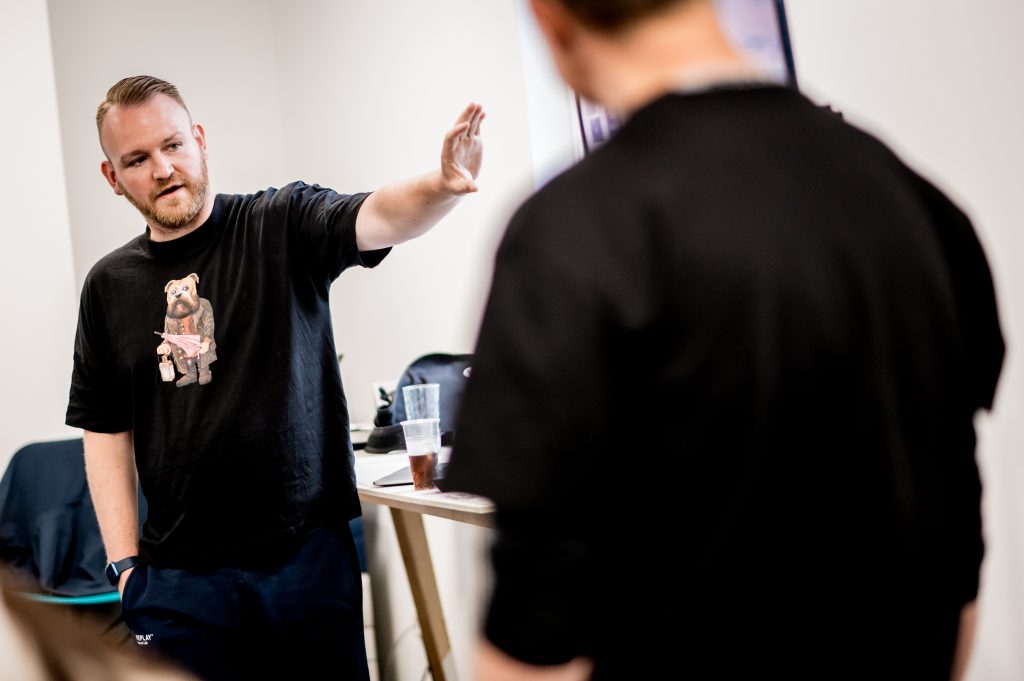If they are not then quite quickly productivity can suffer, engagement of your best employees drops and suddenly your high-flying soaring eagles become a gaggle of lame ducks, customer service dips and the business brand is at risk!
“I agree!” I hear you shout! “How the heck do you monitor team happiness though?”
Marbles! That’s how!
Lets go back nearly 2 years to the beginning of 2016; Blu Sky was (and still is) right in middle of a successful period of growth. That’s got to make everyone really happy right?
Well yeah, especially since the Blu Sky team has always had an amazingly positive, productive engaged ‘togetherness’. Just look at Dave and Jon – they call themselves work husbands… That must mean they are super happy!!
So this happiness thing is the core to Blu Sky culture and as the team grows quickly and a bunch of new faces join us from other firms this dreaded ‘I hate work disease’ will never make its way through the doors of Blu Sky HQ. will it?
Nah, no way hundreds years of awful boring accountancy culture, bad management etc will push Blu Sky off track, will it?
Well thats exactly the questions team Blu Sky asked themselves, and the amazingly simple answer that came back changed Blu Sky forever… so here’s the journey to knowing your team is 87% happy.
- Step 1 – Employee Development
At Blu Sky we take individual career development really, really seriously and we have our very own Aspire development programme run by an outside performance management consultancy, Peak Performance Partnership (3P). Our full team is involved and there is fair amount of science behind the process, content and pace for each member of the team. It was during an off-site that team engagement and happiness began to be discussed and the question of how to capture and monitor happiness got asked. We need to know we are happy and when someone has an off day so we can help them.
- Step 2 – Daily Communication
So to really know what’s going on with everyone in the team we knew we needed to be communicating as a team every day… Not by email or Slack or whatever else comes along, but stood up and face to face. After all, if a manufacturing giant like Nissan can do that then a people-focused chartered accountants firm surely can? So we introduced +QDCI…..a quick, five minute progress update in five areas on a daily basis. + covers health and safety. Q is quality, D delivery, C is cost and I is involvement.
Yes, at Blu Sky we like to do things differently so we made some tweaks along the way, for example C is now V for value.
The essence is largely the same though, and we now have a meeting every day at 11:55am, present some stats on each of these indicators for everyone in the business to hear, and then get back to work happy in the knowledge of where we’re up to. Everyone has the opportunity to shout about what has been going well and those actions to manage any risks lurking on the horizon… What a brilliant thing, to be heard!
- Step 3 – Health and Safety
As you can imagine, in an office environment, we don’t tend to come up against the same sorts of health and safety issues that Nissan do on a factory floor, so we knew we’d have to rethink the traditional view of health and safety.
Mental health was an immediate thought. Why not measure how everyone feels on a daily basis, monitor it, spot any trends or worries and actually understand how our team is doing? Of course us brits are awesome at being open and sharing our feelings, so how hard would that be? We needed something that was a bit less ‘open’, right? A bit like those smiley faces when you walk through Newcastle airport, right? Tap the green face if you are mega happy, the yellow if you are ok or the red faced if you are ‘p*ssed off’!!! We didn’t have all that tech though. We needed something simple…
- Step 4 – Don’t lose your marbles!
We started with a simple idea of popping a marble in a pot as you leave each day. We operated with a traffic light system, with green meaning you’ve had a fantastic working day and you’re happy in your job; yellow meaning you’ve had an average day at work, no complaints; red being that you’ve had a really rubbish day at work and you don’t feel happy. Anonymous. Everyone could say how they really felt.
It worked. We could spot trends throughout our delivery cycle or even days of the week.
Except we started to realise that we didn’t know if it was the same person being unhappy each day, or a variety of us having rubbish days. We knew we needed some way to track it.
- Step 5 – Happy Mood Score
‘Happy Mood Score’ is an online version of what we’d thought up. At the end of the day, you get an email or a slack message asking how your day has been, with a traffic light set of options. Wow! It’s literally our marble pot but in an online format! Surely we can just make the leap, right?
- Step 6 – Monitoring
Enter ‘Trust Manager’. We knew we needed someone who everyone could trust to look at everyone’s responses on a daily basis, and offer a chance to figure out what made that person ‘red’ the day before. Everyone likes a good vent now and then, yeah? But everyone also needed to know that they could still be honest with how they felt at the end of each day.
That’s where I came in!
The team felt that they could all trust me to address any issues they’d had, and only escalate if appropriate, for example if there were any trends amongst the team, or any recurring ‘red days’ from the same person for the same reason.
- Step 7 – Reporting
Each morning, I’ll log onto Happy Mood Score and see how everyone rated the previous day. If anyone was red, I’ll encourage a discussion as to why, and if there were any greens, we’ll celebrate those during our 5 minute meeting! Everyone is encouraged to submit a word to summarise why they chose the colour they did, and these words are also filtered out to the rest of the team. There’s always a competition to see who can submit the most confusing word so the rest of us try and guess what it means!
- There you have it.
We know our team are happy 87% of the time.
Why not check in with your team?











